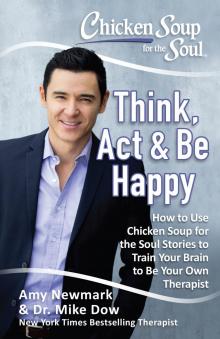- Home
- Amy Newmark
The Joy of Less Page 3
The Joy of Less Read online
Page 3
We’ve learned the importance of what is referred to as the “one thing in, one thing out” rule.
My husband and I have learned quite a few lessons since moving into this house. Living in a small house keeps us looking up. We quickly learned the importance of utilizing vertical space for storage. Shelves and hooks are a functional part of our décor. We’ve learned the importance of what is referred to as the “one thing in, one thing out” rule. When you only have two tiny closets, you quickly learn to exercise restraint when buying clothes, shoes and other wardrobe accessories. When shopping, we now weigh the value and necessity of each potential purchase. Necessary items come home with us; unnecessary items remain in the store. Adding something new and unnecessary to our house would upset the organized, balanced household arrangement we’ve worked so hard to create.
Another lesson we’ve learned is that when you live in a small house, personal space becomes a highly valued commodity. We each need a space to call our own and we respect each other’s personal space. Our house is small and we’ve learned to limit what we bring in, with one exception. We happily share our small home with several pets. It seems that those we rescue understand that our living arrangement is compact and it’s essential that they adapt to it. Animals are not concerned with the size of a house. They only notice the amount of love within the house. I continue to be amazed at how well our pets have adapted to the concept of respecting each other’s personal space as well as the value of togetherness. I take that as further confirmation that rescue pets always seem to have an exceptional sense of gratitude for those who provide a loving forever home for them.
When I look back at some of the houses I’ve lived in, I realize they were larger than what I actually needed. Some rooms were seldom used and a lot of time and money went into the upkeep of those houses. I can honestly say that every part of our current home is used in a functional manner. We’ve learned the value of multi-purpose spaces, multi-purpose furniture and corners.
It’s often said that life is filled with uncertainty. I don’t disagree. However, we have discovered there are some certainties that come with living in a small house. There’s certainly a sense of togetherness that can’t be duplicated in a large house. It’s certain that if we don’t remain organized, clutter will rapidly overtake our living space. For me, I can always be certain that, when I compare the advantages to the disadvantages, small home living comes out the winner. Living in a small home has definitely lessened our need for material possessions. It has given us more time to devote to what matters most, which is time together, quality time with our pets and time to devote to our hobbies.
Small home living enables us to enjoy the things that nurture our souls instead of wasting time and money to satisfy an unhealthy appetite for material possessions. Adjusting to small home living and a simple lifestyle was easier than I would ever have imagined it to be. My only regret is that, even though we were ahead of the downsizing, small home living trends, I wish I had made this choice many years ago.
~Veronica Bowman
Farewell to My Diaries
Memory is the diary we all carry about with us.
~Oscar Wilde
I received my first diary when I was nine. It was pink and pocket-sized, with a gold latch and key. I started writing in it right away.
Fifty years later, I still keep a journal. On its lined pages I plan, dream, storm and mull. Journaling has been my partner all my life.
Over the years I amassed cartons and cartons of journals that I schlepped from town to town, state to state, and country to country. The journals are the record of my life. They’re “me.”
Once in a while, I would think of the dusty cartons taking up more and more space in one basement after another. Then I would imagine them gone, and a sense of freedom and weightlessness would come over me. I mentioned this to my sister, who has planted herself deep in the same plot of North Carolina soil for thirty-five years. “But you can’t throw your journals away!” said Jane. “You can’t! I’ll store them for you!”
“What, ship them all to you?” I said, idly wondering which would be cheaper — USPS, UPS or FedEx. Any way I did it, sending them all the way from California would be an expensive embarrassment.
Keeping a journal is one thing; revisiting it is another. On the rare occasion when I descend into the cave of an old journal, I usually surface feeling morose, relieved to be back in the sunlight. All that drama! All that venting! True, every thirty pages or so I’ll come upon an absolute pearl, and I’ll think, “Gosh, I was brilliant!” But then, along with that comes, “But where did that brilliance go? How come I keep forgetting?”
I debated for years (all the while accumulating yet more journals) whether I should let them go. Always, I hesitated. I respect the value of documentation. Where would history be without records? And who knows, maybe one hundred years from now someone might come upon my journals and read with rapt interest what life was like in the 1960s, 1970s and 1980s, just as we read diaries of the pioneers, or Civil War memoirs.
Then I would imagine them gone, and a sense of freedom and weightlessness would come over me.
Plus, who would I be without my journals? On the other hand, letting go of them might set me free.
Back and forth I went. In one stage I tore out random pages from old journals and collaged them. But that only took care of a few pages.
Finally, somehow, I decided: for now, I’d keep all the journals up to age thirty, and out of the rest, pick fifteen to let go.
I gave my husband the fifteen journals, with the agreement that if within two months I had not asked for them he would “release” them (the phrase “throw away” made me wince). Out of respect for my earlier self, I tore out random pages and collaged them into my art journal. So who-I-was-then is grafted into my current life.
I never did ask him for the journals. I forgot all about them. So they have met their maker. Fifteen journals lighter, fifteen pounds lighter. Now I only have another sixty or so to go….
~Louisa Rogers
In Love with My Life
I find television very educating. Every time someone turns on the set, I go into the other room and read a book.
~Groucho Marx
The wood stove’s cheery flames cast golden light that flickered across my family’s faces. In the still of the evening, gathered in our cozy great room, I knew life didn’t get any better than this. I turned the page and resumed reading out loud to my family. I had never felt so contented, calm, or in love with my life.
I hadn’t always felt that way before we’d moved to the mountains and simplified our living space and belongings. We’d not only downsized, but we’d also cleaned out mental clutter as well, starting with eliminating live television! Right away, something wonderful had happened.
Although I’d never watched a lot of television, the emotions triggered by the stories I’d seen frequently remained in my thoughts for days or even weeks, weighing me down and making me blue. Now, I found myself in better spirits without the violence, disasters, worries, or sadness that the news stations and talk shows had broadcast. The family felt the same way.
Planning was easy now that our schedules no longer centered around a weekly show. The squabbles over who got to watch what ended. In place of the constant noise we found quiet, clearing our minds for the things that mattered in life, especially each other.
An astounding change took place in our children. They didn’t want or need the latest toys, cereals, gadgets, hair or clothing styles because they never saw them advertised on television. They had no idea what was popular. They became their own people, not some clone of the latest movie star or performer. Their creative outlets flourished as they hungrily pursued their own passions. The phrase “I’m bored” vanished.
Together we wrote and put on plays, read books, played games, made family calendars, did arts and crafts projects and plenty more. Enjoying nature, we had plenty of viewing time for the sunset, the sky, the st
ars, or the storm clouds that rolled through.
I can’t help but wonder how many priceless memories never would have been made if we’d kept our television.
If we desired, a VCR gave us the option of watching a special movie, but we controlled the viewing instead of aimlessly channel surfing.
Where family discussions had once centered on that day’s news, or a show we’d seen, or fretting that something terrible we’d seen on TV might happen to us, we made our own news. We talked about our lives, our home and had in-depth conversations with each other. And at last our minds found peace as our family grew closer together.
I can’t help but wonder how many priceless memories never would have been made if we’d kept our television — special times spent together in the great room, or snacking outside on a blanket, watching the stars, even our late-night trips up a mountain road in search of wildlife. I wouldn’t trade those moments for all the sitcoms, talk shows, and movies in the world.
We’ve lived more than twenty years without live television. Our children are grown, but the question still pops up from inquisitive friends. “You don’t have live television? How do you live without it?”
“We live much better than we did with it,” I always answer, and that’s the truth.
~Jill Burns
The Dream Home
Be grateful for the home you have, knowing that at this moment, all you have is all you need.
~Sarah Ban Breathnach
“Nobody’s ever home around here,” my friend said, looking around at the large and beautiful homes in her new neighborhood. She had just moved to an affluent area in our town and I had come to visit her.
“What do you mean?” I asked.
“Well, everybody’s working all the time. I guess they have to in order to be able to afford to live here,” she said, smiling.
I looked around at the palatial homes, all new, with perfectly manicured lawns and vast amounts of square footage. I began to think about how nice it would be to live in one of them. My mind began to race with questions….
Wouldn’t I feel better about myself if I lived here? Wouldn’t I be happier? I began to think about our budget and how we could possibly stretch it to cover the monthly mortgage payments. As I envisioned myself in this beautiful neighborhood, I realized I would also need a newer car and a nicer wardrobe to fit in.
Soon the pangs of discontentment began to stir within me. I began comparing these dream homes to my humble one and suddenly other things in my life needed an upgrade, too. My car was not quite good enough and my clothes were in desperate need of an update. By comparison, nothing I had was good enough.
My house, after all, had been built in the Brady Bunch era of the 1970s when Jimmy Carter was still president. It was located in the more affordable, working class part of town. It met all of my family’s needs, certainly, but it was paltry in comparison to the palaces lining this street.
But other questions nagged, too, forcing me to give my daydreams a reality check. If we lived here, would my husband’s work commute increase so that he would be home less? What other areas of our budget would have to be slashed in order to cover a bigger mortgage payment? How much longer would it take us to pay off the mortgage? Would we be borrowing against our future, making early retirement an impossible dream? Would our travel opportunities be drastically reduced because we would be putting all our money into a house we could barely afford?
Instead of thinking of all the ways my home and possessions were lacking in comparison, I began to think of all the advantages I had in staying where I was.
Reality began to set in as I started to add up the actual cost of living in one of these so-called dream homes. Instead of thinking of all the ways my home and possessions were lacking in comparison, I began to think of all the advantages I had in staying where I was. Because I lived in a more affordable home we could comfortably live on one income and I could be a stay-at-home mom. We could afford a couple of vacations each year without going into debt. We could save a good portion of our income for retirement and investments because all our money wasn’t going to the mortgage payment.
I began to realize that there are different types of currency besides money and possessions. And that it didn’t make sense to work more to afford a lifestyle I would have less time to enjoy.
As I drove back that evening and the houses got smaller and grew older with each passing mile, I began to realize that I already had my dream home. One that enabled me to have freedom from loads of debt while still meeting all of my family’s needs. I didn’t need a certain zip code or amount of square footage to make me happy.
As I pulled into my driveway that night, I felt peace and gratitude for all that I had, all the things that can never be bought.
~Suzannah Kiper
The Decades Long Dream
Heirlooms we don’t have in our family. But stories we’ve got.
~Rose Cherin
As newlyweds, my husband and I dreamed big. Not of money and mansions and expensive cars, but of something far more difficult to attain in today’s society. We dreamed of simplicity.
On weekends, we’d leave our hectic city jobs behind, pack a lunch, and drive to the mountains, where we’d romp beside clear cool streams. Our favorite part of the day, however, was watching the Arizona sunset explode across the sky, spilling layers of crimson and gold onto the valley below. When darkness finally fell, we’d wait for lamplights to glow like fireflies from the windows of tiny cabins that peppered the night with their warmth. Leaning against a beefy Ponderosa pine, my idealistic young husband would draw me into his arms and whisper, “Someday, we’re going to live in a little cabin in the mountains.”
I’d sigh. “With a rocking chair on the porch?”
“Two.” He’d grin. “For growing old together.”
“For rocking grandbabies.” I’d say.
“We’ll have a Jeep.” He was adamant about that.
“And get a dog?” I’d ask.
“Of course.” He’d promise. “I’ll build furniture and chop firewood.”
“And I’ll bake bread and write books.”
We’d often fall asleep on a bed of soft pine, dreaming of that simple home in the mountains where we’d live happily ever after.
Life went on. I devoted my time to home schooling our three children while he devoted his days to earning a living in corporate America until a layoff, after twenty plus years of service, shook our world. But at the bottom of the rubble, our dream remained.
When a series of job related moves led us closer to family again, we bought a weekend cottage in one of our favorite places, the Ozark Mountain foothills. The old stone cottage was tiny, but it came with a mighty view from a ridge high above the river. Little did we know that within a year it would become our permanent home.
After twenty plus years of marriage, moving into a home with less than half the space required considerable downsizing. While the process proved to be cathartic, it was far from simple. Where does one begin?
Lives are not connected by objects but by stories about those objects.
For us, the first to go were gently worn clothes, coats, shoes and extra bedding. Missions and shelters covet such things. Our books were tougher to part with. Avid readers, we’d envisioned a wall-to-wall library complete with sliding ladder, but our cottage would only accommodate our very favorite reads. The day we discovered e-readers was transformative.
Photographs and artwork by family members went with us. I’d periodically swap them out, a bit like a museum that rotates its collection on display! Because storage is at a premium in micro kitchens, small appliances were replaced with multitasking gadgets, or not replaced at all. Nightstands doubled as dresser drawers. We added closet organizers, lots of hooks, and my cedar chest became our coffee table.
While deciding whether a possession would be moved into the cottage with us, one simple question determined its fate. “Where will we put it?” This was the litmus test for belov
ed trinkets and furniture alike. One piece of furniture caused quite a dilemma, but it also taught me an invaluable lesson.
For years, I’d grown up hearing my dad promise to fix the old black teacart that sat in our kitchen. Because it had come from my grandmother, I’d had an affinity for the fragile old thing. As a young adult I’d acquired the teacart, and for nearly thirty years we moved it from house to house all across the country. The wheels were broken, the veneer was peeling, the pins were gone, and the thing wobbled and tipped. My husband had promised to fix it, but he never got around to it. When my cousin saw the teacart in such disrepair, he also promised to fix it, but instead he moved away and the teacart remained.
When my kids were small, I felt the need to protect Grandma’s teacart, so I kept it tucked safely in a corner, away from their rambunctious play and Hot Wheels. By the time our younger son had grown, the teacart had become a liability rather than an asset. He promised to fix it for me too, but then he got married and started a family and had repairs of his own. I propped the teacart behind a couch to protect our grandchildren from getting hurt on the splintered old relic. When the time came to decide what would go to the cottage and what would not, I wasn’t sure the old thing would survive the cut. I mentioned my dilemma to my dad.
“Then why try to move it?” he asked.
“Because I don’t think I can bring myself to leave behind a family heirloom.”
“Heirloom?” he chuckled. “Are we talking about the same teacart?”

 Chicken Soup for the Soul
Chicken Soup for the Soul The Joy of Less
The Joy of Less Hope & Miracles
Hope & Miracles The Cat Really Did That?: 101 Stories of Miracles, Mischief and Magical Moments
The Cat Really Did That?: 101 Stories of Miracles, Mischief and Magical Moments The Joy of Christmas
The Joy of Christmas My Very Good, Very Bad Dog
My Very Good, Very Bad Dog My Very Good, Very Bad Cat
My Very Good, Very Bad Cat